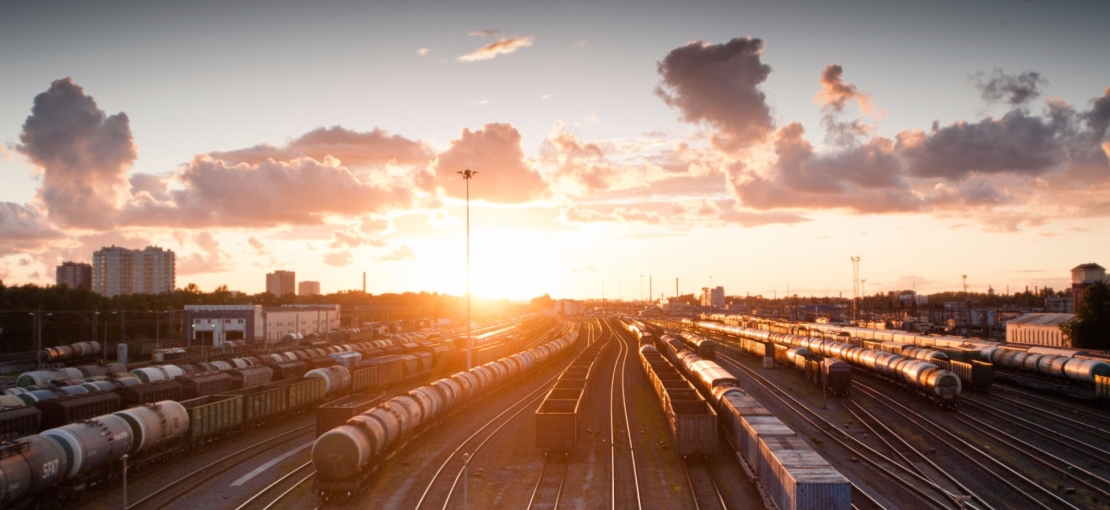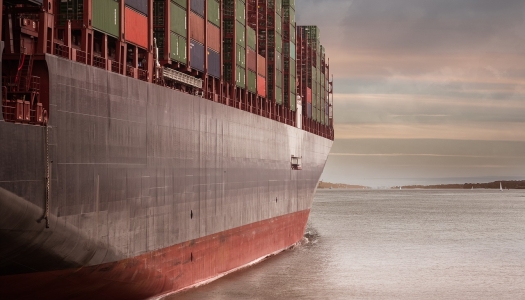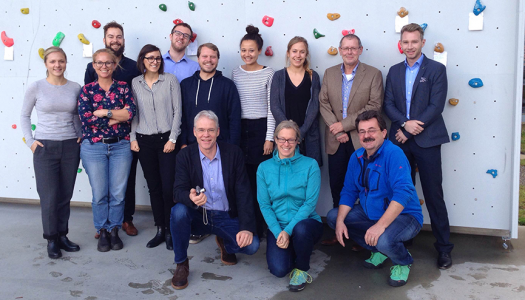
Halfway around the world – yet still eco-friendly?
Climate-neutral transport by ship and rail
We live and work in a globalized world. Before reaching customers, our products travel long distances. We’ve long been aware that this generates emissions, even though the greatest percentage of our products by far travel the longest distances by container ship and rail.
We have examined where changes can be made to reduce transport emissions and how to set these changes in motion in a Green Logistics Project.

|
Arrival by ship
Ship transport produces very few emissions per ton of freight, even when the voyage goes halfway around the world. |
VAUDE products are primarily transported by large container ship and by train from their production facilities to our warehouse. This type of transport is responsible for a very low amount of emissions per individual product. All emissions from the transport of VAUDE products are included in the VAUDE climate footprint. Since 2021, we have integrated these emissions into the VAUDE climate offset. By making a payment to a climate protection project by myclimate, they are considered climate neutral. More about the VAUDE climate footprint here
The results of our research project have confirmed that sea freight also contributes significantly to environmental pollution and that we cannot just sit back and relax when it comes to our our current merchandise logistics.
Our goal, therefore, is to reduce emissions and pollutants from merchandise logistics. With its clear commitment to science-based climate goals, VAUDE is also committed to taking on the major challenge of reducing emissions from upstream processes.
This also includes merchandise logistics that are still currently shipped with petroleum-based transport. As a medium-sized company, VAUDE has too little influence to persuade container ship owners to switch to renewable energies, especially since we do not work directly with them, but with (mostly also medium-sized) freight forwarders, such as the Munich-based Group7. Working together, we are advocating for greater sustainability in logistics in our industry associations. More about VAUDE's political demands here.
Green Logistics research project reveals optimization potential
Eight students from the interdisciplinary course of study, Risk Assessment and Sustainability Management (RASUM), at the Technical University Darmstadt dealt with the issue of how VAUDE can optimize its transport in order to reduce emissions over a period of several months.
Logistics emissions included in the VAUDE Climate Footprint
The VAUDE Climate Footprint is the foundation for the Green Logistics Project. All relevant logistics data has been collected annually since 2011 by our partner shipping companies and flows into the annual VAUDE Climate Footprint. Read more here
The research group examined the transport routes of VAUDE products to VAUDE in light of ecological, economic and social aspects:
1. Which logistics options are available now and which will be available in the future?
2. What is the potential for reducing emissions of merchandise logistics?
3. What strategies and measures can VAUDE implement to achieve this?

|
Hard work with exciting results:
The RASUM student group of the Darmstadt University of Applied Sciences with Prof. Führ, the logistics service provider Group7, VAUDE Logistics Manager Uwe Abraham and Hilke Patzwall, Senior CSR Manager at VAUDE. |
Hilke Patzwall, Senior CSR Manager at VAUDE, reports on the research project:
Specifically, the students dealt with the following sub-projects regarding the transportation of products from the manufacturer to VAUDE:
- Flow of merchandise analysis Asia
- Options for relocating production sites
- Alternative transport routes, i.e. through Triest vs. Hamburg
- Ecological evaluation of various transport options
- Comparison of rail vs. air freight from Asia
- Direct delivery to customers
- Collaboration options
- Funding
Implementing measures successively
Working together with the experts of the Group7 logistics company and its scientific network and supported by their professor Martin Führ, the students used the data and facts provided by VAUDE to develop eleven recommendations on how we can reduce logistics emissions.
These include measures that can be quickly implemented and we will introduce at least some of them, for example, rail transport through Asia instead of airfreight and participation in logistics networks.
Other measures are more complex to implement and will have a serious impact on our processes. We are integrating these measures into our company goals and budget allocation so that we can tackle them step by step. Some optimizations require new software before we can implement them. In the new merchandise management system that VAUDE is currently introducing, we also want to integrate route handling so that we can use the data available in the system and little manual effort to optimally monitor the transport of goods in relation to time, costs and emissions.
Climate-neutral transport of VAUDE products from the production plant to the customer
The majority of the products are transported by ship from our producers to Hamburg. (If you want to know where our production partners are located around the world, you can find out more here). From the port of Hamburg, the products travel to Ulm by rail and are then delivered to Tettnang-Obereisenbach by truck. From an ecological perspective, transport by ship and rail makes the most sense.
Whenever it is possible in light of customs legalities and organizational considerations, goods are delivered directly from producer to our major customers or to the recipient country without a detour into our warehouse, for example, to our customers within Asia - see also Our Customers and Markets.
We try to avoid airfreight from producers to VAUDE – the costs alone are reason enough for this. Sometimes, however, we have no other choice in order to deliver goods on time to our customers.
The processes in our own warehouse in Tettnang-Obereisenbach have already been largely optimized by state-of-the-art technology. The dispatch from the central warehouse in Obereisenbach to our customers (specialist dealers) is pack volume optimized and collected by truck - first with fully loaded container units to the shipping company hub, then by truck to the respective region, and only the last 20 kilometers by courier vehicle. Our shipping partners themselves highly value climate protection and are continuing to develop further in this area.
Both the delivery of the products to VAUDE and the deliveries to our customers are climate neutral.
We do not have any impact on the transport of materials from various upstream suppliers to our apparel manufacturers. Generally speaking, even though we designate which materials they should use, we do not buy them ourselves. Read more here. By sensitizing our producers to environmental issues, we want to raise their awareness of transport emissions.
This graphic presents the various delivery scenarios of emissions per ton of freight. Calculations were made by the non-profit organization myclimate. It is clear that based on the weight of an individual product, ocean freight is only a tiny fraction per ton of freight. Once products are flown, however, emissions are high.
Emissions arising from freight logistics
Myclimate uses cargo flow data from our shipping partners to determine VAUDE’s emissions from deliveries and shipments as part of our annual climate footprint report. This transport consists primarily of VAUDE products, of course, but it also includes everything else that is transported on behalf of VAUDE – coffee for our employees, shop fittings for VAUDE stores and materials that are used in the VAUDE Manufaktur production facility here in Germany.
Emissions – Delivery to VAUDE Tettnang
Create your own infographicsThe sharp increase in emissions from air freight compared to 2019 is not the result of an increase in air freight in 2020. Starting in 2020, emission factors for flights were adjusted by myclimate so that one ton of air freight is now calculated to cause significantly more emissions than before. As a result, air freight accounts for the majority of delivery emissions, even though VAUDE transported the smallest amount in weight by air – less than 1% in 2019 and 1.4% in 2020.
Although it might not be apparent in this chart (due to the fact that freight is only recorded in the main leg/the longest distance traveled): All containers that arrived in Hamburg by sea freight in 2020 were transported by rail from there to Ulm.
Emissions – Delivery / Shipping from VAUDE Tettnang
Create your own infographicsEmissions per ton of freight
Create your own infographicsLow transport emissions per product
| GRI: | 302-1 |
| GRI: | 302-2 |
| GRI: | 302-3 |
| GRI: | 302-4 |
| GRI: | 302-5 |
| GRI: | 305-3 |




